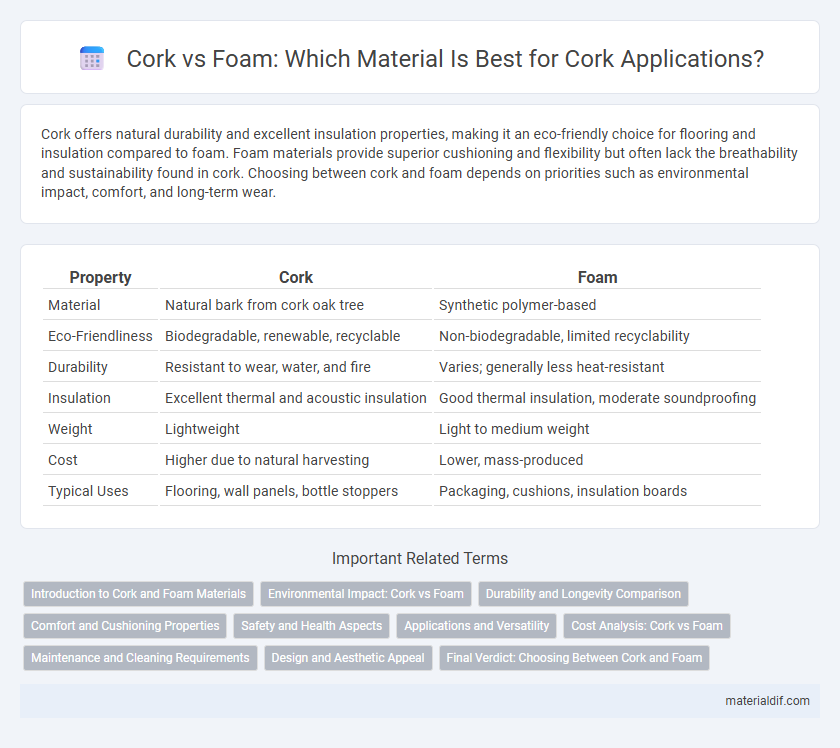Cork offers natural durability and excellent insulation properties, making it an eco-friendly choice for flooring and insulation compared to foam. Foam materials provide superior cushioning and flexibility but often lack the breathability and sustainability found in cork. Choosing between cork and foam depends on priorities such as environmental impact, comfort, and long-term wear.
Table of Comparison
| Property | Cork | Foam |
|---|---|---|
| Material | Natural bark from cork oak tree | Synthetic polymer-based |
| Eco-Friendliness | Biodegradable, renewable, recyclable | Non-biodegradable, limited recyclability |
| Durability | Resistant to wear, water, and fire | Varies; generally less heat-resistant |
| Insulation | Excellent thermal and acoustic insulation | Good thermal insulation, moderate soundproofing |
| Weight | Lightweight | Light to medium weight |
| Cost | Higher due to natural harvesting | Lower, mass-produced |
| Typical Uses | Flooring, wall panels, bottle stoppers | Packaging, cushions, insulation boards |
Introduction to Cork and Foam Materials
Cork, harvested from the bark of cork oak trees, is a natural, renewable material known for its lightweight, resilient, and insulating properties. Foam, typically made from synthetic polymers like polyurethane, offers versatile cushioning and soundproofing capabilities with varying densities and firmness. Both materials are widely used in construction, packaging, and design, but cork stands out for its sustainability while foam excels in customizable performance.
Environmental Impact: Cork vs Foam
Cork is a sustainable and eco-friendly material harvested from the bark of cork oak trees, which regenerate without harming the tree, resulting in minimal environmental impact and carbon sequestration benefits. In contrast, foam is typically derived from petroleum-based products through energy-intensive processes, contributing to pollution, non-biodegradable waste, and higher carbon emissions. Cork's biodegradability and renewable sourcing make it a superior choice for reducing environmental footprints compared to synthetic foam alternatives.
Durability and Longevity Comparison
Cork offers exceptional durability due to its natural cellular structure, resisting wear and moisture over time better than many foam materials. Foam, especially lower-density types, tends to compress and degrade quickly under consistent pressure, reducing its lifespan significantly compared to cork. The longevity of cork flooring or insulation can exceed decades when maintained properly, whereas foam products often require replacement within a few years.
Comfort and Cushioning Properties
Cork offers natural cushioning with its cellular structure that compresses under pressure and quickly rebounds, providing firm yet comfortable support ideal for flooring and footwear insoles. Foam, particularly polyurethane or memory foam, excels in plush cushioning by contouring to body shapes and evenly distributing weight, enhancing comfort during prolonged use. While cork is breathable and resilient with moderate shock absorption, foam delivers superior softness and adaptability, making it preferable for applications where maximum comfort and pressure relief are essential.
Safety and Health Aspects
Cork is a natural, hypoallergenic material that resists mold, mildew, and dust mites, making it a safer choice for indoor environments compared to foam, which can off-gas volatile organic compounds (VOCs) and trigger respiratory issues. Cork's breathability and moisture resistance reduce the risk of allergens and bacteria buildup, promoting healthier air quality. Foam products, especially polyurethane foam, may contain flame retardants and chemicals linked to skin irritation and long-term health concerns.
Applications and Versatility
Cork excels in sustainability and insulation, making it ideal for flooring, wall coverings, and acoustic panels, while foam offers superior cushioning and flexibility used extensively in packaging, furniture, and automotive seating. Cork's natural fire resistance and moisture regulation provide unique advantages in eco-friendly construction, whereas foam's lightweight and moldable properties suit custom-fit applications and thermal insulation. Both materials serve niche markets effectively, with cork favored in green building and interior design, and foam dominating sectors requiring impact absorption and comfort.
Cost Analysis: Cork vs Foam
Cork offers a higher upfront cost compared to foam but provides long-term savings through durability and low maintenance requirements. Foam insulation typically costs less initially, making it attractive for budget-conscious projects, yet may require more frequent replacement or repair. Evaluating total lifecycle expenses, cork's natural resilience often results in superior cost-effectiveness over foam in sustainable building applications.
Maintenance and Cleaning Requirements
Cork flooring requires minimal maintenance, involving regular sweeping and occasional damp mopping to prevent dirt buildup and preserve its natural resilience. Foam mats are even easier to clean, typically needing only a simple wipe-down with a mild detergent and water, making them highly resistant to stains and moisture. Both materials resist dust accumulation, but cork's porous nature demands more attentive cleaning to avoid water damage compared to the waterproof and quick-drying properties of foam.
Design and Aesthetic Appeal
Cork offers a warm, natural texture that enhances interior design with its organic patterns and subtle color variations, creating an inviting and sophisticated aesthetic. Foam provides versatility in shape and vibrant color options, but lacks the unique, eco-friendly charm cork inherently possesses. The choice between cork and foam depends on whether a design prioritizes sustainable elegance or customizable, bold visual impact.
Final Verdict: Choosing Between Cork and Foam
Cork offers natural durability, sustainability, and excellent thermal and acoustic insulation, making it ideal for eco-friendly projects. Foam provides superior cushioning, lightweight properties, and cost-effectiveness, suitable for applications requiring flexibility and shock absorption. Choosing between cork and foam depends on project priorities such as environmental impact, durability, comfort, and budget constraints.
Cork vs Foam Infographic

 materialdif.com
materialdif.com